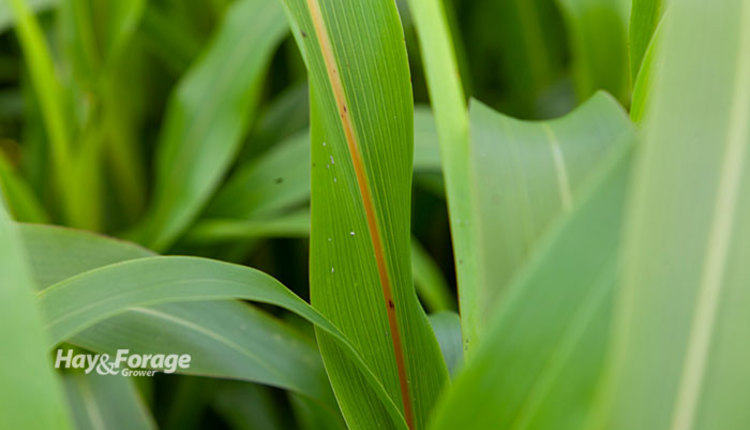
It’s a guarantee that cool-season grass pastures will take a break this summer when hot, dry conditions set in. It’s also likely that some conventional dairy and beef operations will need additional forage to boost inventories for cows or heifers. To overcome these forage-deficit issues, sorghum species — more than ever — are being used.
Sorghums have become popular from north to south and are no longer considered just an “emergency” forage. Currently, there are several companies that specialize in sorghum breeding and are bringing products to the market designed specifically for more Northern adaptation and performance. Further, a great deal of company investment has gone into breeding and developing sorghum hybrids with useful traits that overcome some of their challenges experienced in years gone by.
More and more, farmers are planting sorghum species as a standard practice for grazing and mechanically harvesting. As soil temperatures begin to warm, now is the time to formulate a sorghum species plan.
Advances in forage breeding aren’t just being made with traditional one-cut forage sorghums; they are also occurring with sorghum-sudangrass hybrids and sudangrass. These versatile grasses are being chopped for silage, wrapped into baleage, and grazed. Less frequently, dry hay is being harvested, especially if sudangrass is used.
Both one-cut and multi-cut systems of harvest are options across the sorghum forage species spectrum, although most research has shown that a single-cut strategy will result in the highest yields and lowest forage costs. Grazing is also a viable alternative during the “summer slump.” Whether grazing or cutting, leave a 6- to 8-inch stubble for faster regrowth potential.
The number of possible traits available for selecting a sorghum species hybrid seems to grow with each passing year. There are single-cut sorghums bred specifically for forage, and the brown midrib (BMR) trait is available across all the product lines, including sorghum-sudangrass and sudangrass.
Photoperiod-sensitive lines are also an option. This trait keeps plants in a vegetative state much longer, allowing for higher forage quality and a wider harvest window. This trait allows for all of the nutrients to remain in the plant tissue rather than being translocated to a seedhead.
Another choice in forage sorghums is the brachytic dwarf trait. These hybrids have shorter stalk internodes, which result in a leafier plant. Some brachytic dwarf hybrids are available with the BMR trait. Before buying sorghum seed, it pays to do some homework and figure out what types will perform best in a specific forage system and at a given latitude.
In recent years, herbicide tolerant sorghum hybrids have been made available, and soon there will dhurrin-free hybrids that eliminate the risk of prussic acid poisoning.
Perhaps sorghum’s best characteristic is its ability to perform when other cool-season forages are withering under summer’s heat and dryness. As such, sorghum species of all types have proven to be a feed-source savior during droughty summers, offering utility for producers who both mechanically harvest or graze the crop. Sorghums fit well into a winter and summer annual double-crop system.
Of course, sorghum species do come with some challenges. In the South, sugarcane aphids have become a major pest issue. Hybrid selection and other mitigation strategies can lessen their impact.
For Northern farmers, the largest obstacle comes when an unusually cool summer occurs. Although sorghums perform well in warm weather, just the opposite is true when temperatures drop. Growers also need to be cognizant of prussic acid and forage nitrate issues in certain situations.
Plan for success
It’s generally recommended to plant sorghum species after soil temperatures reach 65°F and will stay there for the immediate future. Cold soil is a death wish for sorghums.
Planting depth also can mean the difference between establishing a successful stand or not. The target depth is about 3/4 to 1 inch. Matt Atkins, a dairy nutritionist with the U.S. Dairy Forage Research Center who has done considerable sorghum research, cautions against seeding sorghums into clay soils just prior to forecasted significant rainfall. “Our experience is that soil crusting can drastically reduce emergence,” he notes.
Tom Kilcer, a crop consultant based in Tennessee, suggests drilling full-season sorghums in narrow rows or planting in 15-inch rows or less. This will maximize sunlight interception early in the growing season.
Kilcer has also completed trials with the smaller seeded sorghum-sudangrass planted at higher seeding rates. He bumped up the seeding rate to about 60 pounds per acre and obtained high yields with no weeds. Yields equaled or even exceeded that of sorghum, he notes.
Finally, don’t forget about nitrogen and potassium fertilizer. Similar to corn, sorghum is a grass plant that needs both. Kilcer also recommends that some sulfur be applied along with the nitrogen fertilizer.

